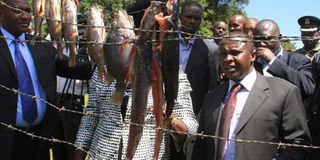No keen fish eaters in Nyeri but ponds flourish to feed outsiders

PHOTO | FILE Fisheries Principal Secretary Micheni Ntiba in Nyeri recently.
What you need to know:
- Most of the produce is consumed outside the county
- With a mini fish-processing plant at Wamagana area in Tetu, the county government has declared it does not want to take control of running the daily affairs of the processing plant but wants to grow fish farming in the county.
When the government introduced fish farming through the Economic Stimulus Programme (ESP) in the 2009/10 financial year, nobody imagined that Nyeri county would become the leader in fish production.
Last September the county was reported to have produced more than 21,800 metric tonnes of fish from ponds in 2012, compared to 12,154 metric tonnes produced by the entire country in 2010.
The Department of Fisheries figures were presented to a fishery stakeholders’ workshop organised by the Karatina University.
But despite such numbers, it is rare to see anyone selling fish on the streets of Nyeri town, and local food joints do not feature fish on the menu as do those in other towns around the country.
Most of the fish raised and harvested in the county is consumed outside Nyeri.
“But now we want to encourage Nyeri people to start eating fish,” said Nyeri county executive member for agriculture Shadrack Mubea.
In 2009/10, free ponds were built and stocked with at least 1,000 fingerlings each under the ESP, and the fish farmers got free feed to last for six months.
It took farmers in the Mount Kenya region some time to get used to the idea that once they had received training and been given everything they needed, they were expected to move to the next stage on their own.
“If a person is supposed to help you walk, once you rise up, you are supposed to continue walking, but you should not wait for somebody else to continue holding your hand,” said Mr Mubea.
But some farmers have been complaining that the project was not viable, and they are not making money from it.
Some of the farmers who ventured into the project at its inception have opted out citing lack of good returns.
But the Mount Kenya Fish Farmers Association said: “Some of these farmers who are complaining that the venture is not paying off are those who started practising fish farming because the government was supporting them with free things.
“Those who are still in the venture are benefiting,” said association chairman David Mureithi, who added that farmers who understood the process have been making money.
The officials say they have a problem with some of the farmers who stopped maintaining their ponds after ESP support ended.
“Some farmers expected that after harvesting their first crop, the government would come back and give them free fingerlings,” said Prof Charles Ngugi.
Prof Ngugi said the problem is with the management of the ponds at the individual level.
Fish farmers in the county are organised into clusters of 20 to 30; the region has about 3,000 fish ponds, 10 dams and a number of rivers, and the county government is trying to move into the sector to revitalise it. The county has registered one of the highest adoption rates with more than 70 per cent of the beneficiaries of ESP retaining the ponds.
“The ESP was supposed to help farmers get some alternative source of income besides dairy, tea, coffee and horticulture sectors,” said Mr Mubea.
However, the marketing structures are not well defined and the county government is in the process of holding a fish stakeholders’ forum.
With a mini fish-processing plant at Wamagana area in Tetu, the county government has declared it does not want to take control of running the daily affairs of the processing plant but wants to grow fish farming in the county.





